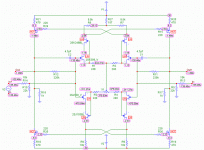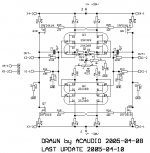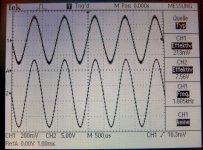metalman,
When I started the Aleph-X, there were no hints. No one could have been any more surprised than I was when Nelson said he was about to release a commercial product that was similar. To me, it was just a technical exercise in joining the Aleph and X topologies. The DC offset question can be addressed in several ways, some more effective than others. Nelson doesn't, for instance, use a servo, but it's entirely effective and will provide a one-stop solution for those who are bothered by thermal DC drift at the outputs.
There's a curious thing about expressing yourself. When I first started playing bass, I wanted to play "like" Geezer Butler (Black Sabbath in the early '70s incarnation of the band), then for the longest time I wanted to play like Chris Squire (Yes), then Stanley Clark (Return To Forever era)...but a funny thing happened right about then...I realized that it was more about picking up a given technique than trying to play note for note "like" any given bass player. That's when I began to develop my own style instead of being a Stanley-clone or whoever the flavor of the month might be. Thus, when I heard Billy Sheehan (Talus, Mr. Big) I looked, not at trying to get his tone, or his stage moves, or whatnot, but just the tapping & hammering. It took a month or two, but I got what I wanted and moved on. (And yes, I got an idea or two from Jaco Pastorius, but never went through a phase of wanting to play like him. Why, I don't know. By all rights, I should have spent years trying to copy his every note.)
The same thing is true in electronics. Pick up a concept, be it Nelson's Aleph current source or sliding class A, and put it in your bag of tricks. There it sits, like differentials, cascodes, and all the other stuff you'd see in a textbook. No one wants to design "like" a textbook, nor should they. This is all by way of saying that trying to design "like" Nelson shouldn't be the goal, any more than playing bass "like" Geezer Butler. Putting a cascode in may be the right thing to do for a particular circuit...or it may not. Putting one into a 20W amp just because Nelson put a cascode in a 150W amp isn't necessarily the right thing to do. Look at your intended application before summarily deciding that "of course" it has to have a cascode.
The reason I like Nelson's stuff is that there are more ideas there than in most other gear. Endless iterations on the standard three stage amp are just as boring (to me) as playing 12 bar blues. Can't do it. I go bonkers. An entire night of playing the same 1-4-5 progression kills brain cells. Gimme something where I can stretch out. The same is true--at least for me--in electronics. I don't care a whit that my Aleph 2s are different from the production model. Ditto for the Aleph-X, etc. There's no need to have an exact resistor-for-resistor copy of Nelson's commercial product. We have the oft-noted capability to bypass mundane commercial realities and do something gloriously impractical in the DIY realm.
Turn off your targeting computer...use the Force, Luke.
Grey
When I started the Aleph-X, there were no hints. No one could have been any more surprised than I was when Nelson said he was about to release a commercial product that was similar. To me, it was just a technical exercise in joining the Aleph and X topologies. The DC offset question can be addressed in several ways, some more effective than others. Nelson doesn't, for instance, use a servo, but it's entirely effective and will provide a one-stop solution for those who are bothered by thermal DC drift at the outputs.
There's a curious thing about expressing yourself. When I first started playing bass, I wanted to play "like" Geezer Butler (Black Sabbath in the early '70s incarnation of the band), then for the longest time I wanted to play like Chris Squire (Yes), then Stanley Clark (Return To Forever era)...but a funny thing happened right about then...I realized that it was more about picking up a given technique than trying to play note for note "like" any given bass player. That's when I began to develop my own style instead of being a Stanley-clone or whoever the flavor of the month might be. Thus, when I heard Billy Sheehan (Talus, Mr. Big) I looked, not at trying to get his tone, or his stage moves, or whatnot, but just the tapping & hammering. It took a month or two, but I got what I wanted and moved on. (And yes, I got an idea or two from Jaco Pastorius, but never went through a phase of wanting to play like him. Why, I don't know. By all rights, I should have spent years trying to copy his every note.)
The same thing is true in electronics. Pick up a concept, be it Nelson's Aleph current source or sliding class A, and put it in your bag of tricks. There it sits, like differentials, cascodes, and all the other stuff you'd see in a textbook. No one wants to design "like" a textbook, nor should they. This is all by way of saying that trying to design "like" Nelson shouldn't be the goal, any more than playing bass "like" Geezer Butler. Putting a cascode in may be the right thing to do for a particular circuit...or it may not. Putting one into a 20W amp just because Nelson put a cascode in a 150W amp isn't necessarily the right thing to do. Look at your intended application before summarily deciding that "of course" it has to have a cascode.
The reason I like Nelson's stuff is that there are more ideas there than in most other gear. Endless iterations on the standard three stage amp are just as boring (to me) as playing 12 bar blues. Can't do it. I go bonkers. An entire night of playing the same 1-4-5 progression kills brain cells. Gimme something where I can stretch out. The same is true--at least for me--in electronics. I don't care a whit that my Aleph 2s are different from the production model. Ditto for the Aleph-X, etc. There's no need to have an exact resistor-for-resistor copy of Nelson's commercial product. We have the oft-noted capability to bypass mundane commercial realities and do something gloriously impractical in the DIY realm.
Turn off your targeting computer...use the Force, Luke.
Grey
Why would one choose for a lower Idss in this particular circuit?acaudio said:
Actually I use a mix 2SK389V +2SJ109BL, I looking for 389BL...,
but no problem... it works
/Hugo
Netlist said:
Why would one choose for a lower Idss in this particular circuit?
/Hugo
In fact, you should have a look for max. power dissipation of the JFETs. It´s the limiting factor. By voltage loss of ~15V at DS and 10mA saturation current (for V instead BL) you go in dangerous region. For biasing the mosfet stage are needed aprox.10-15V across R6-R9.
Adam
From simulation (have no real devices at hand) I’ve got 26,29V over R6 and 27,67V over R9. This results in a bias current of 2,77mA through the fet stages.
I read somewhere that ideally the fets should be biased at Idss for best performance.
If this is correct we should aim for 6-12mA for the BL version.
Lowering the supply resistors to 5k results in saturation of the cascode fets although the current rises to 3.27mA.
I’m I way out of track here? Bear with me, I’m horrible with maths.
/Hugo
I read somewhere that ideally the fets should be biased at Idss for best performance.
If this is correct we should aim for 6-12mA for the BL version.
Lowering the supply resistors to 5k results in saturation of the cascode fets although the current rises to 3.27mA.
I’m I way out of track here? Bear with me, I’m horrible with maths.
/Hugo
Attachments
Netlist said:From simulation (have no real devices at hand) I’ve got 26,29V over R6 and 27,67V over R9. This results in a bias current of 2,77mA through the fet stages.
I read somewhere that ideally the fets should be biased at Idss for best performance.
If this is correct we should aim for 6-12mA for the BL version.
Lowering the supply resistors to 5k results in saturation of the cascode fets although the current rises to 3.27mA.
I’m I way out of track here? Bear with me, I’m horrible with maths.
/Hugo
Sorry Hugo, your simulation is no similar with real life.
Here the measured voltages (circuit without cascode):
across R6-R9 each ~ 15V
across R18-R21 each ~11,5V
across R1-R4 each ~380-390mV
Uds Q1-Q2 each ~ 14,6V
Uds Q7-Q10 each ~18,5V
Ijfet ~1,5mA
Imosfet~24mA
Lowering the R9-R21 alone gives no mentioned changes, my first circuit had 4,75k.
Idss from datasheet is range of available. The highest value is at Ugs=0V. With R1-R4 you stabilize the bias point to a small range of Idss in relation to Uds variation, lowering the value of R1-R4 gives a higher current, but gives more distortion and noise (in theory?). In figure of my circuit lowering down to 100 Ohm should be good. (with lowering R9-R21 too) The first values are intuitive, I´ll try the lower values.
Regards
Adam
acaudio said:
Here the measured voltages (circuit without cascode):
across R6-R9 each ~ 15V
across R18-R21 each ~11,5V
across R1-R4 each ~380-390mV
Uds Q1-Q2 each ~ 14,6V
Uds Q7-Q10 each ~18,5V
Ijfet ~1,5mA
Imosfet~24mA
Just changed:
R1=R2=124 Ohm
R3=R4=100 Ohm
R18-R21=4,7k
Here the actually measured voltages :
across R6-R9 each ~ 12,8V
across R18-R21 each ~9,1V
across R1-R4 each ~340mV
Uds Q1-Q2 each ~ 16,8V
Uds Q7-Q10 each ~20,9
Ijfet ~2,75mA
Imosfet~19mA
Power dissipation Jfet~46mW (Pd=200mW)
Effect: Square wave at 10kHz is a little more "square"
Edit: Just compared: the square form is the same than from generator direct.
Should we go down?
Adam
gl said:... My choice for the UGS would be to use MPSA42's (or similar) with the 2SK389 and MPSA92's (or similar) with the 2SJ109's. ..
Hi,
I believe Mr Pass may actually prefer a pair of ZTX450/550's for cascoding his fets in this particular case
Regards,
Milan
acaudio said:Cascode version works,
I built it different to my previous schematic with two 2SK389 and two 2SJ109.
Hi Adam and everybody
Jocko pointed out something very interesting regarding cascodes: http://www.diyaudio.com/forums/showthread.php?postid=616474#post616474
As you used J-FET's, that would be OK I guess....
Two questions:
Did you measure open loop gain on your circuit? I am curious...
Did you also consider to try a folded cascode arrangement?
Thanks
Tino
zinsula said:
Hi Adam and everybody
Jocko pointed out something very interesting regarding cascodes: http://www.diyaudio.com/forums/showthread.php?postid=616474#post616474
As you used J-FET's, that would be OK I guess....
Two questions:
Did you measure open loop gain on your circuit? I am curious...
Did you also consider to try a folded cascode arrangement?
Thanks
Tino
Hello,
for first, here the actually schematic , I try at present lower values for R1-R4 (R6-R9 and R18-R21 too).
Tino,
I believe more to statement from really developers , which use fets since more tens of years, they should know it. Such as Mr.Pass or Mr. Borbely. At the moment I have no really good idea, which would be so simple and good as cascoding jfet by jfet. In figure of noise anyway. I´m open for any good example.
For measurements, wait please a moment, I have today an better oscilloscope from my work...
Adam
Attachments
zinsula said:Did you measure open loop gain on your circuit? I am curious...
Hi Tino,
just measured:
open loop gain is 31dB (only R11/R12 removed) see pic, and 34dB if input signal measured after R13/R14 (not divided). Removing or higher value of R16/R17 should giving higher open loop gain, but this low value is helpful to stabilise this circuit.
Adam
Attachments
thomasfw said:Dear Adam,
When will you perform the "Human Ear" testing ?
That is most interesting !
We all know good "Hi Fi" is not equal to Measure Data !
Please let us know !
Best Regards !
Thomas

Maybe next weekend? I wait for parts... (BL)
Particularly I want to build a pcb for easy changing with the Aleph P1.7 PCB, but I´m no sure if this is the right way in look at volume control at output. For test I think about a replacement of IRFD110/9110 with IRF610/9610 with higher bias.
For good understanding of this circuit are measurements important.
Adam
zinsula said:Did you buy the last truckload from those parts?
I often buy as much as a 5 year supply of critical parts. As long
as you know you'll use them, it's an excellent investment.
Some years ago the industry suffered a Mosfet famine when the
automotive industry ate up all the parts and IR's new plant was
behind construction. One amplifier company went out of business
and another announced a triumphant return to Bipolar parts.
I was sitting on about 7 years worth of IR parts at the time.
Nelson Pass said:
I often buy as much as a 5 year supply of critical parts. As long
as you know you'll use them, it's an excellent investment.
Some years ago the industry suffered a Mosfet famine when the
automotive industry ate up all the parts and IR's new plant was
behind construction. One amplifier company went out of business
and another announced a triumphant return to Bipolar parts.
I was sitting on about 7 years worth of IR parts at the time.
and even if you don't plan to use them, I'm sure you won't have difficulties to sell dual toshiba jfets
Not a few dual Jfets left to sprinkle over the poor DiyAudio members heads for a reasonable price?...and testing purposes of course.Nelson Pass said:I often buy as much as a 5 year supply of critical parts.

/Hugo
george a said:In my ignorance I can't help but wonder how the MOX discrete op amp stage compares to all this...and if and where it fits in...
The MOX discrete stage was reverse engineered from the
schematic in the XVR1 manual, which showed the circuit without
the component values. As to how it fits in, it's just another
circuit, but is not set up for SuSy, nor do we make it as a
module.
- Status
- This old topic is closed. If you want to reopen this topic, contact a moderator using the "Report Post" button.
- Home
- Amplifiers
- Pass Labs
- X2_ugs3,4



